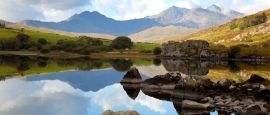Wales Weather, climate and geography
Weather & climate
Wales tends to be wetter than England, with slightly less sunshine. Temperatures in the coastal areas, however, can be very warm in summer ranging from 15°C (59°F) to rare highs of around 25°C (77°F). Conditions in upland areas such as the peaks of Snowdonia or the Brecon Beacons can be changeable at all times of the year. Be prepared for sudden downpours in summer as well as winter.
The summer months of June to August are the hottest, though they are also the busiest as they coincide with the school holidays. Beaches are heaving with families, hotels are rammed and attractions are a frenzy of queues. For those able to travel outside of the holidays, May and September will offer lovely warm days without the hectic crowds.
Similar to the rest of the UK, dress according to season. Waterproofs are advised for both the winter and summer; take a look at the weather forecast before embarking on outdoorsy activities. Take strong hiking boots if doing any trekking through mountainous areas, and warm clothes such as fleeces and thermals are likely to be required for upland areas. During summer if the weather is good, lightweight fabrics are fine, although it is always sensible to take some heavier layers, just in case the weather turns.
Geography
Wales is a country of great geographical variation with many long stretches of attractive and often rugged coastline. South Wales is mainly known for its industrial heritage but the western part of the coast between Carmarthen Bay and St David's is similar to that of the more pastoral west country of England, and backed by some equally beautiful countryside.
The scenery of Mid-Wales includes rich farming valleys, the broad sandy sweep of Cardigan Bay and rolling hill country. North Wales is one of the most popular tourist areas in the British Isles, with many lively coastal resorts. Inland, the mountainous region of Snowdonia has long been popular with walkers and climbers. Much of the central inland area of the country is mountainous, with some breathtaking scenery; many striking lakes can be found inland. The region of Snowdonia in the north covers an area of 2,130 sq km (822 sq miles), extending from the north and western coasts of Wales, inland towards Bala and Llandrillo. Snowdon is the second highest peak in Britain, after Scotland’s Ben Nevis, standing at 1,085m (3,560ft) above sea level.
Further south, the Brecon Beacons is another mountain range running from Hay on Wye in the east to Llandeilo in the west, covering 1,344 sq km (519 sq miles). The highest peak in the range is Peny Y Fan 886m (2907ft).
Do you have any Feedback about this page?
© 2025 Columbus Travel Media Ltd. All rights reserved. No part of this site may be reproduced without our written permission, click here for information on Columbus Content Solutions.




 You know where
You know where